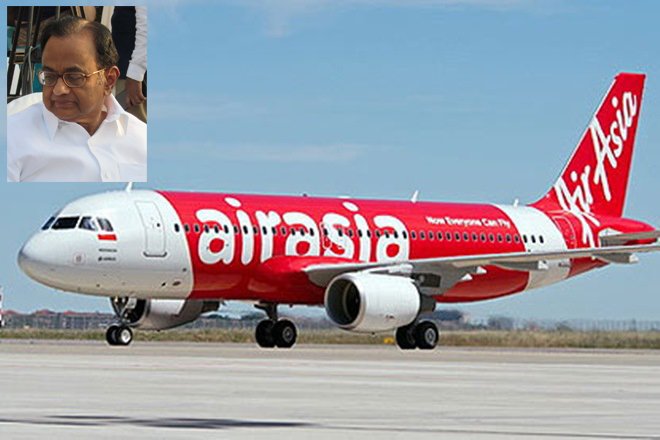The Foreign Investment Promotion Board (FIPB), which was directly under the control of the Ministry of Finance, then headed by P. Chidambaram, cleared in record time the proposal submitted jointly by AirAsia and the Tata Group to start a low cost airline. In February 2013, AirAsia officially announced that it, along with the Tata Group, was planning to establish a domestic airline in India. It was in the same week that AirAsia reported to the Kuala Lumpur Stock Exchange that it had applied to India’s FIPB for permission to establish an airline in a venture with Tata Sons and businessman Arun Bhatia of Telestra Tradeplace. The FIPB cleared the proposal on 6 March 2013, overruling all reservations put forth by the Ministry of Civil Aviation. Subsequently, on 20 September 2013, AirAsia got the NOC (no objection certificate) from the Ministry of Civil Aviation and on 7 May 2014, while the general elections were in their last leg, it received the no flying objection from the Directorate General of Civil Aviation. This was the last clearance it required.
In effect, AirAsia was able to fly in the Indian skies within 14 months—February 2013 to May 2014—of submitting its first documents with Government of India, seeking various approvals.
At present, AirAsia is under the scanner of the Central Bureau of Investigation for allegedly entering into a conspiracy with government servants and politicians to expedite the approval process and change India’s aviation policy to suit its needs. Among the ten people named in the CBI FIR as “accused” is the group CEO, Tony Fernandes, who has been summoned for questioning by the Central agency.
According to sources, the speed with which AirAsia was able to overcome policy indecisiveness and ministerial and bureaucratic hurdles—a hallmark of the UPA regime of the time—was by virtue of the “help” it received from various quarters, including an influential minister, despite the Civil Aviation Minister raising strong objections against granting a flying licence to the airline.
The then Civil Aviation Minister, Ajit Singh had opposed granting permission to AirAsia, citing the fact that a Cabinet decision passed on 20 September 2012, related to FDI in civil aviation, had not given any company the permission to start a new airline, but had only allowed foreign airlines to invest in existing airlines that were operating in India.
The Cabinet decision that Ajit Singh was referring to was “Note 6 of DIPP—’Review of the policy on Foreign Direct Investment in the Civil Aviation sector’.” It was passed in September 2012, and it stated, “The Government of India has reviewed the position and decided to permit foreign airlines also to invest, in the capital of Indian companies, operating scheduled and non-scheduled air transport services, up to the limit of 49% of their paid-up capital.”
The AirAsia-Tata plan, according to Ajit Singh, was a completely new venture, with the Malaysia based AirAsia having a 49% stake in AirAsia India, Tata Sons Ltd 30%, and Arun Bhatia, who owned Telestra Tradeplace Pvt Ltd, with 21%. Arun Bhatia left the venture in 2016, alleging that the airline was being controlled by AirAsia Malaysia. Bhatia’s son Amit is the son-in-law of L.N. Mittal. Mittal’s daughter Vanisha Mittal is married to Amit.
“They were so confident of getting the FIPB approval despite the inherent problems (strong opposition from Ministry of Civil Aviation, apart from massive pressure on the government from the existing airline to not allow AirAsia to fly in India) that they started recruiting people for their India operations from March 2013 itself. Officially, the documents seeking the necessary approval were submitted by AirAsia to FIPB in February 2013. The approval was given within 30 days and that tells the story about how quickly the files moved in the otherwise lackadaisical desks of the Ministry of Finance. Technically, the objections raised by Ajit Singh to stop AirAsia from getting the approvals, for whatever reasons, were sound as the reading of the September 2012 decision will make it clear. Despite that, the FIPB approval was given to AirAsia in a jiffy and subsequently everything fell in place, even the objections that were being raised by the people in the Ministry of Civil Aviation were ‘handled’,” said a source familiar with the development.
According to sources, AirAsia was given an in-principle guarantee by “people”, whose promises held value, that it would not face any problems despite the 5-20 rules and the September 2012 DIPP decision. The 5-20 rule, which was introduced in 2004 and subsequently scrapped in June 2016, required that an airline should have flown domestic routes for at least five years and have at least 20 aircraft at its disposal before being allowed to fly on international routes.
“Even before it entered into a joint venture with Tata, AirAsia, during its interaction with Ministry of Finance officials, through middlemen, made it clear that it wanted to start flying international
In consonance with the promise that was made to AirAsia, a proposal to amend the 5-20 rule was drafted, seconded by the Ministry of Civil Aviation in February 2014, so that it could be taken up in the Cabinet meeting. However, as luck would have it, the Election Commission announced the general elections and the said draft could not be deliberated upon.

